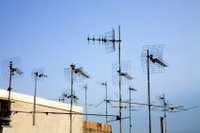Types of TV Antennas

Types of TV antennas vary. The difference between UHF and VHF TV antennas is mainly size. The antenna size varies depending on the signal wavelength received. To receive channels in both UHF and VHF frequency bands a broadband antenna will be necessary.
The higher the channel, the smaller the antenna. For example, UHF antennas are smaller than VHF antennas because the channel frequency is higher.
Indoor antennas are generally small and designed to be placed near your TV set. Outdoor antennas are significantly larger and are made to go on your roof or in an attic.
Generally, the larger the antenna, the stronger the signal it will provide to the TV set.
Almost all outdoor antennas perform better than the best indoor antennas. Indoor antennas of course have a size disadvantage over outdoor antennas.
Splitting the antenna signal between two or more TVs will reduce the available signal greatly. Even splitting the signal once may cause the loss of one or more channels.
Antennas can be affected by walls, fluorescent lights, computers, cordless phones, and even by people moving around in the room.
To help with the size disadvantages, you can use an electronic amplifier that will enhance the signal. The amplifier may be built in or it can be a separate device that installs in between an outdoor antenna and the TV set.
You should only use an amplifier if you have to because an amplifier also amplifies noise along with the signal. This amplified noise can sometimes overpower the signal and can make your reception worse.
Return from TV Broadcast to EZ Digital TV Home Page